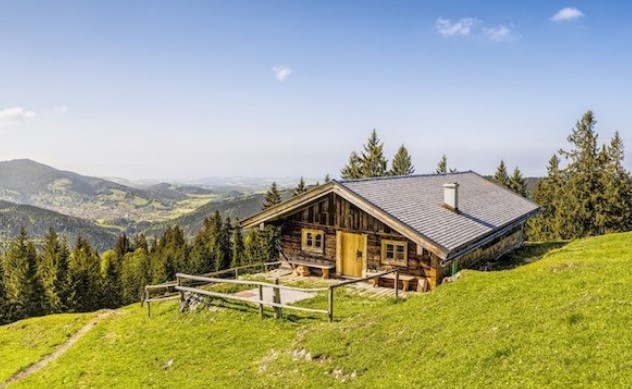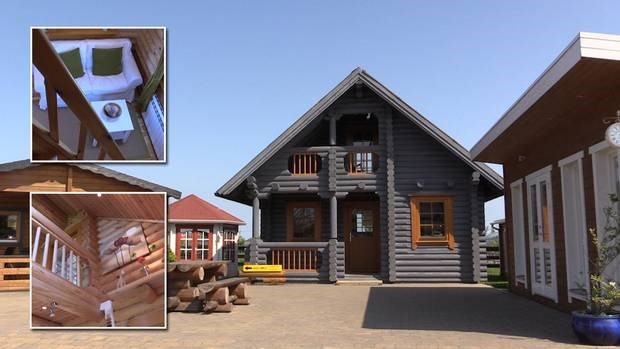
Like every other house exposed to the elements, Residential log cabins are neither maintenance-free nor are they, absolute killers, to take care of. I don’t think it would be an exaggeration to state that the first couple of years demand significantly more work than your standard-issue house – unless, of course, you can afford to pay someone to do the work for you! Log cabin preparation and the base coat of stain are critical to the long-term success of your wall protection. But once the initial work is done, the maintenance becomes routine, and I would venture to guess Residential log cabins are a little easier to care for than other wooden houses. After all, you don’t have to strip the stain off between coats.
LOG PREPARATION:
Most construction sites become a sea of mud in a short period of time. The soil has been disturbed and there’s no grass to hold the dirt together (or absorb the rain). You’ll discover that the first few log courses are absolutely pristine, but the higher the walls become, the more the logs get dropped, smudged, or even used as stepping stones to dryer places (like the port-a-potty). Once the Log house is up, the logs Cabin will have to be washed before applying a stain… both inside and out.

Doing the interior cleaning in the right order didn’t occur to us – especially since the logs cabins Dublin were erected in the winter. In our case, the timing was all wrong; you really want to wash the interior walls before the finished floor is laid, and before the basement insulation is installed under the floor decking. We didn’t make it, and we had to follow our wall-washing with a shop-van to get rid of all the water… what a mess!
It was recommended that we use a mixture of one part bleach and four parts trisodium phosphate. We scrubbed it on with a brush and rinsed it off. Some people recommend a power washer for the outside walls, but you must use great care, and apply with a fan-tip to avoid damaging the logs cabin Ireland. The experts recommend corn cob-blasting, but this is an expense most of us can’t afford. If you do use a power-washer, it’s a good idea to follow up with a shop-van and vacuum out the water that will pool inside the checks, so that the logs don’t get saturated from water sitting in the cracks. Even so, it will take one or more days to dry completely, depending on the weather.
Once the small logs cabins are dry, it is recommended that you apply a borate treatment before applying the stain. This borate is not only an insecticide, but it also protects against rot. Usually, this comes as a powder, and is mixed with water and sprayed on with an ordinary garden sprayer. Make sure it doesn’t rain between applying the borate and the stain, or the borate will probably wash out.
STAINING:
All stains are not created equal. There is a big performance difference between the best and the worst, so make sure you don’t try to save money by cutting corners on the stain – you’ll pay for it later. A deck sealer just won’t work for logs; you should use a product specially designed for log cabins, and you won’t find it at your local hardware store. Most stains need to be applied in two or three coats, so make sure your painter knows this when going for a quote. You will want to stain the exterior as soon as possible after the house is erected; it’s amazing how quickly the logs will turn gray under normal exposure.
Afterward, a “maintenance coat” of stain needs to be applied every 2-5 years, depending on the exposure. You usually don’t have to retain the whole house at one time. You’ll see the color lighten up as the stain wears thin – for lack of a better word. If you’re not sure whether a new coat is required, run a hose on the wall and see if the water beads up. If it does not, you’re probably ready for another coat. And no, you don’t have to strip off the old stain first, unless it has been neglected and shows sign of flaking and chipping. If your walls have gone 10 years without a second coat, you may have to corn-blast and start over. In this case, consult a specialist.
RAILING SYSTEM:
The weak link of every log home is the railing system -,, especially on an exposed deck. The junctures between the rails and spindles need to be caulked thoroughly, and you’ll see many more checks in the little railings giving the opportunity to let rain in. The railing system needs to be retained every year. Make sure you don’t let any water drip on the railings; gutters are a must.
CAULKING:
It is a personal preference whether or not you caulk the exterior of your garden rooms, but common sense would tell us that it’s good policy to lock out the elements. There are caulks specifically designed for log homes that remain supple and give with normal expansion & contraction. In the first couple of years, it is advised to caulk any checks that appear on the upper curve of the log surface, where rain might collect. These caulks will take a stain, so they tend to blend in. After the house has reached equilibrium with its environment, the checking will cease.
INSECTS:
What to look for. For the most part, there is visual evidence of any insect problem. Make it a policy to inspect your small log cabins in the spring and in the fall, and be sure to keep your walls free of foliage, dead leaves, etc. Bushes should be planted a minimum of 2 feet away from the walls. Don’t stack firewood against the wall, or anything else that could provide a home for unwelcome critters, four-legged or six-legged ones.
BOTTOM LINE:
At coppolacabins.com, Maintenance of log home is done in a routine, and the best defense is keeping a careful eye on abnormalities. Discoloration of a corner probably means water is dripping on it. A little pile of sawdust probably means a boring insect. Holes in the log cabins, regardless of how tiny, are a red flag. These are the kinds of things you’d look for with any house. And after you’ve had your inspection, relax on the deck and enjoy your home… you deserve it.
Author Bio-
Andrew Thomas is Managing Director and Story Teller at Coppola Cabins. He has studied Real Estate Business for years. He enjoys connecting with people, keeping updated with the latest in the field of Real Estate, Construction, and Business, etc. He has also discovered great shortcuts that can help investors make better decisions when it comes to buying and selling. His work across multiple disciplines broadly addresses the narratives of human experience.
He has also discovered great shortcuts that can help investors make better decisions when it comes to buying and selling. His work across multiple disciplines broadly addresses the narratives of human experience.


